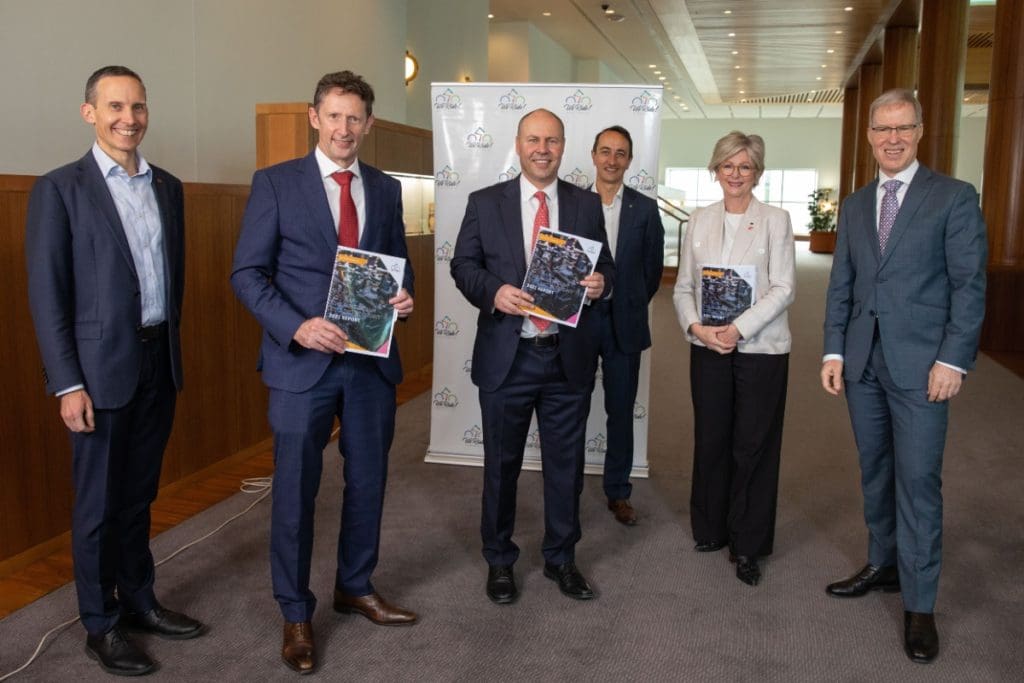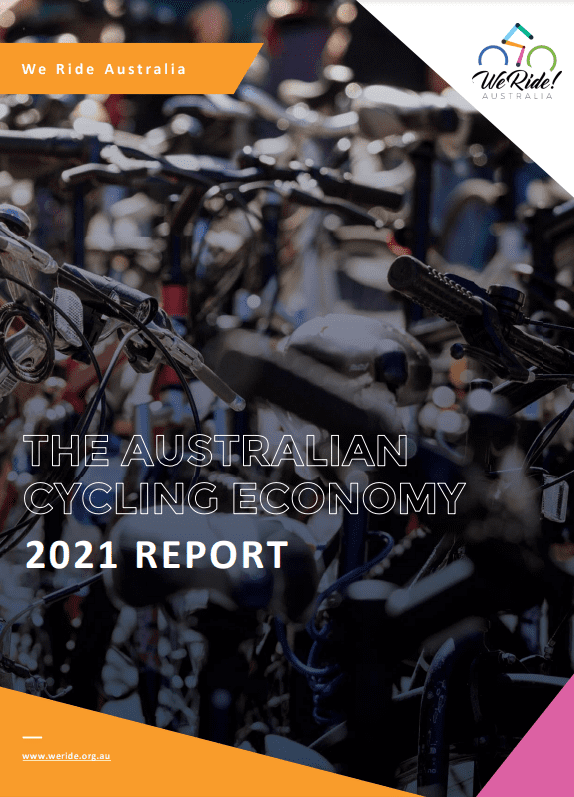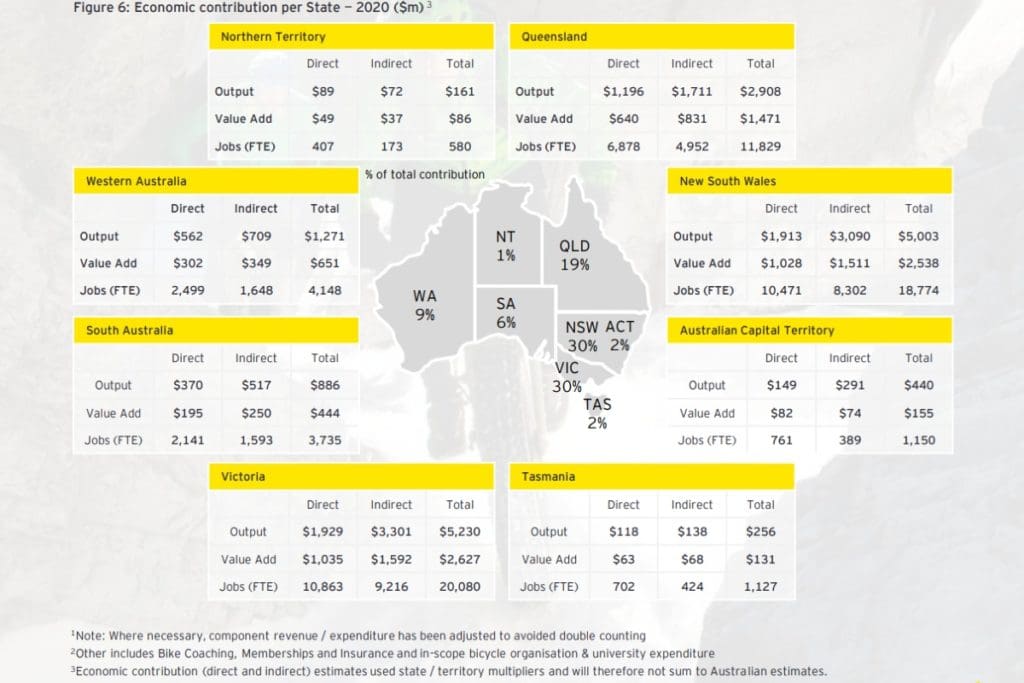Cycling’s $6.3 Billion Injection to Australian Economy

Canberra, ACT
Australia’s cycling industry directly contributed $3.4 billion to the nation’s Gross Domestic Product (GDP) in 2020 and had a total direct industry output of $6.3 billion for the year, according to an Australian-first report spearheaded by the We Ride Australia cycling advocacy group and released last week.
The We Ride Australian Cycling Economy Report, produced for We Ride by international accounting firm Ernst & Young, quantifies cycling’s contribution to the Australian economy and aims to position the industry for greater support from all levels of government.
The report’s key statistics for 2020 include:
- A total of $16.8 billion in direct and indirect economic contributions, supporting 60,330 direct and indirect jobs nationally
- Australia’s cycling industry directly supported 34,295 jobs
- 5.8 million (29%) of Australian adults spent money on cycling-related goods and services
- 3.3 million Australians spent money on cycling and cycled at least once a week
- 1.7 million bikes purchased, worth approximately $1.5 billion
- 28% of bicycles purchased were children’s bikes
- While exercise and fitness were the most common reasons to ride a bike (82%), 41% of those surveyed cycled as a mode of transport
- $1.168 billion contribution from cycle tourism to the direct economic output
The document was officially launched by the Federal Treasurer, Josh Frydenberg, during an online event attended by several of Australia’s top industry heads and many of the nation’s most influential cycling advocates.
“The numbers in this report are very interesting,” according to Mr Frydenberg, who described himself during the launch as “a very humble mamil”.
“The We Ride Australian Financial Report confirms what we instinctively knew – that cycling is a major economic driver. What we get from this report is how it has an impact in so many different ways.
“I think you can use the data to leverage more investment in cycling infrastructure and open up more areas for cycle-related activities,” he said.
“The numbers make a very compelling case for more investment in cycling infrastructure because it has a real multiplier effect.”
He said the more people riding bikes, the more people selling bikes, the more people fixing bikes and the growth of other ancillary services.
Treasurer Recognises Need for Cycling Infrastructure
The Treasurer noted the growing number of people using bikes to commute and said it was necessary to provide more bike lanes and bike paths to service those commuters.
He said the report showed cycling is not a rich person’s sport but is an activity pursued by Australians across all income brackets.
Mr Frydenberg highlighted the economic importance of recreational cycling and cited the example of Derby, the Tasmania mining town that had “two feet in the grave” in 2014 but has been rejuvenated as a mountain bike mecca.
We Ride’s Director – National Advocacy for We Ride Australia, Stephen Hodge, celebrated the report and its launch as an unprecedented high point and important milestone for the Australian cycle industry.
Mr Hodge said the report’s statistics – for the first time presenting the “hard dollars” of cycling’s contribution to the nation’s economy – and the level of support among politicians and industry leaders put Australian cycling in an unprecedented position to attract more investment and infrastructure.
“Giving context to the impact of the sector, the $3.4 billion of direct value add to our GDP is more than three times the Australian motorsport industry ($1.0 billion 2019) and level with the Australian thoroughbred racing industry,” Mr Hodge says in a statement issued for the launch.
“We’re very pleased that the report by EY substantiates the significant value of investment in infrastructure and programs that allow more Australians to ride.
“With 4.62 million Australians riding a bike in a typical week and 10.19 million riding in the last year, the numbers of Australians choosing to ride a bicycle is a massive opportunity we can build on.
“It was particularly pleasing to observe that the data highlighted that 28 per cent of bicycles were purchased for children. Let’s invest to allow them to develop healthy, active habits for their future health and wellbeing.”
Parliamentary Friends of Cycling
Mr Frydenberg was joined at Parliament House for the launch by several members of the Parliamentary Friends of Cycling, a program of We Ride Australia comprising Federal politicians from each of the major parties and Independent Members.
The three Co-Chairs of the Parliamentary Friends – the Liberal Member for Wentworth, Dave Sharma, the Labor Member for Fenner, Dr Andrew Leigh, and the Independent Member for Indi, Dr Helen Haines – each spoke at the launch.
Mr Sharma, who initiated the Parliamentary Friends group with Mr Hodge, said the report also “shows just how much room there is for cycling to grow in Australia”.
He said while there will be many politicians surprised by how many people have embraced cycling, Australia was “really just getting started” as a cycling nation and as a destination for bike tourism.
Mr Sharma added cycling had a big role to play in achieving net zero emissions.
“We need to get more electric vehicles, we need more charging stations but we also need more cycling infrastructure and more people on bikes,” he said.
Dr Haines said regional and rural areas, such as her Victorian seat of Indi, knew the value of the cycling industry to drive economic recovery, particularly after setbacks such as major bushfires and the COVID pandemic.
She said getting people on bikes not only achieved the physical benefit of reducing car use, it also had the ethereal advantage of taking people out into the natural environment and showing them what is at stake as a result of climate change.
Last week’s launch was supported by the International Cycling Executives (ICE), a group of high-level business people brought together by their love of cycling. ICE encouraged participants to join the breakfast-time event using Zwift and to pedal their way through the event.
The CEOs for Bunnings, Westpac, EY Oceania, Salesforce A&NZ and AusCycling spoke at the launch. Each of them advocated the importance of encouraging cycling and several outlined improved end-of-trip facilities their companies had provided for staff.
AusCycling CEO Marne Fechner told the launch her organisation was “all in” to assist in further developing the cycling industry.
She said AusCycling is now better placed to play a role in nurturing cycling as a whole, after the national peak cycle sports administration body had undergone major change – bringing together road, mountain bike and BMX under one organisation and absorbing the operations of the State bodies.
The We Ride Australian Cycling Economy Report was completed with the financial support of Advance Traders, Auscycling, Bike SA, Bosch Australia, Giant Bicycles Australia, Pon.Bike Australia, Shimano Australia, Specialized Bicycles Australia, Trek Bicycles Australia and Westcycle.
Join the Conversation
Do you think the economic report will provide a major boost to attract government support for the cycling industry?


